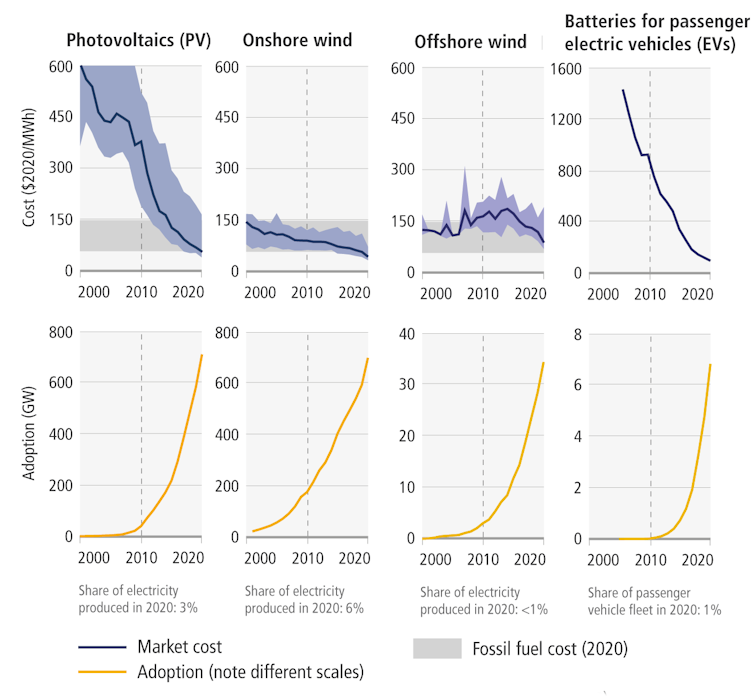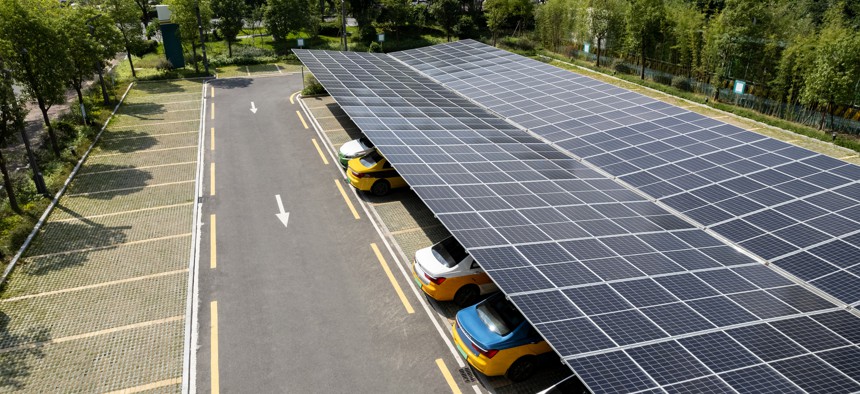Connecting state and local government leaders
The rise in telework, electric vehicle adoption and shared mobility services like Uber and Lyft are reducing carbon emissions and bringing about systemic changes to the transportation sector.
Around the world, revolutionary changes are under way in transportation. More electric vehicles are on the road, people are taking advantage of sharing mobility services such as Uber and Lyft, and the rise in telework during the COVID-19 pandemic has shifted the way people think about commuting.
Transportation is a growing source of the global greenhouse gas emissions that are driving climate change, accounting for 23% of energy-related carbon dioxide emissions worldwide in 2019 and 29% of all greenhouse gas emissions in the U.S.
The systemic changes under way in the transportation sector could begin lowering that emissions footprint. But will they reduce emissions enough?
In a new report from the Intergovernmental Panel on Climate Change released April 4, 2022, scientists examined the latest research on efforts to mitigate climate change. The report concludes that falling costs for renewable energy and electric vehicle batteries, in addition to policy changes, have slowed the growth of climate change in the past decade, but that deep, immediate cuts are necessary. Emissions will have to peak by 2025 to keep global warming under 1.5 degrees Celsius (2.7 F), a Paris Agreement goal, the report says.

The transportation chapter, which I contributed to, homed in on transportation transformations – some just starting and others expanding – that in the most aggressive scenarios could reduce global greenhouse gas emissions from transportation by 80% to 90% of current levels by 2050. That sort of drastic reduction would require a major, rapid rethinking of how people get around globally.
The future of EVs
All-electric vehicles have grown dramatically since the Tesla Roadster and Nissan Leaf arrived on the market a little over a decade ago, following the popularity of hybrids.
In 2021 alone, the sales of electric passenger vehicles, including plug-in hybrids, doubled worldwide to 6.6 million, about 9% of all car sales that year.
Strong regulatory policies have encouraged the production of electric vehicles, including California’s Zero Emission Vehicle regulation, which requires automakers to produce a certain number of zero-emission vehicles based on their total vehicles sold in California; the European Union’s CO2 emissions standards for new vehicles; and China’s New Energy Vehicle policy, all of which have helped push EV adoption to where we are today.
Beyond passenger vehicles, many micro-mobility options – such as autorickshaws, scooters and bikes – as well as buses, have been electrified. As the cost of lithium-ion batteries decreases, these transportation options will become increasingly affordable and further boost sales of battery-powered vehicles that traditionally have run on fossil fuels.
An important aspect to remember about electrifying the transportation system is that its ability to cut greenhouse gas emissions ultimately depends on how clean the electricity grid is. China, for example, is aiming for 20% of its vehicles to be electric by 2025, but its electric grid is still heavily reliant on coal.
With the global trends toward more renewable generation, these vehicles will be connected with fewer carbon emissions over time. There are also many developing and potentially promising co-benefits of electromobility when coupled with the power system. The batteries within electric vehicles have the potential to act as storage devices for the grid, which can assist in stabilizing the intermittency of renewable resources in the power sector, among many other benefits.
Other areas of transportation are more challenging to electrify. Larger and heavier vehicles generally aren’t as conducive to electrification because the size and weight of the batteries needed rapidly becomes untenable.
For some heavy-duty trucks, ships and airplanes, alternative fuels such as hydrogen, advanced biofuels and synthetic fuels are being explored as replacements for fossil fuels. Most aren’t economically feasible yet, and substantial advances in the technology are still needed to ensure they are either low- or zero-carbon.
Other ways to cut emissions from transportation
While new fuel and vehicle technologies are often highlighted as decarbonization solutions, behavioral and other systemic changes will also be needed to meet to cut greenhouse gas emissions dramatically from this sector. We are already in the midst of these changes.
Telecommuting: During the COVID-19 pandemic, the explosion of teleworking and video conferencing reduced travel, and, with it, emissions associated with commuting. While some of that will rebound, telework is likely to continue for many sectors of the economy.
Shared mobility: Some shared mobility options, like bike and scooter sharing programs, can get more people out of vehicles entirely.
Car-sharing and on-demand services such as Uber and Lyft also have the potential to reduce emissions if they use high-efficiency or zero-emission vehicles, or if their services lean more toward car pooling, with each driver picking up multiple passengers. Unfortunately, there is substantial uncertainty about the impact of these services. They might also increase vehicle use and, with it, greenhouse gas emissions.
New policies such as the California Clean Miles Standard are helping to push companies like Uber and Lyft to use cleaner vehicles and increase their passenger loads, though it remains to be seen whether other regions will adopt similar policies.
Public transit-friendly cities: Another systemic change involves urban planning and design. Transportation in urban areas is responsible for approximately 8% of global carbon dioxide emissions.
Efficient city planning and land use can reduce travel demand and shift transportation modes, from cars to public transit, through strategies that avoid urban sprawl and disincentivize personal cars. These improvements not only decrease greenhouse gas emissions, but can decrease congestion, air pollution and noise, while improving the safety of transportation systems.
How do these advances translate to lower emissions?
Much of the uncertainty in how much technological change and other systemic shifts in transportation affects global warming is related to the speed of transition.
The new IPCC report includes several potential scenarios for how much improvements in transportation will be able to cut emissions. On average, the scenarios indicate that the carbon intensity of the transportation sector would need to decrease by about 50% by 2050 and as much as 91% by 2100 when combined with a cleaner electricity grid to stay within the 1.5-degree Celsius (2.7 Fahrenheit) target for global warming.
These decreases would require a complete reversal of current trends of increasing emissions in the transportation sector, but the recent advances in transportation provide many opportunities to meet this challenge.
![]()
Alan Jenn, Assistant Professional Researcher in Transportation, University of California, Davis
This article is republished from The Conversation under a Creative Commons license. Read the original article.



